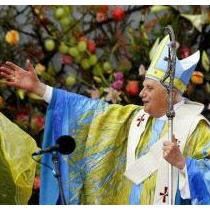
For example, though he had walked through the same door countless times before, Bishop David A. Zubik could enter St. Paul Cathedral in Oakland on Thursday night only after knocking. Pondering this symbolic act that was foreign to me, I could think of several bits of Biblical references that might have inspired the tradition. First, to come to mind was the scripture from Matthew that says, "Ask and it will be given to you; seek and you will find; knock and the door will be opened to you. For everyone who asks receives; he who seeks finds; and to him who knocks, the door will be opened.” Also, Rev. 3:20, “Here I am! I stand at the door and knock. If anyone hears my voice and opens the door, I will come in and eat with him, and he with me.” The messages of these passages to persist in finding God and while also leaving the door to our hearts consistently open to God (personally and corporately) are ones we probably couldn’t hear often enough.



